Star-filled Euclid images spur mission to probe 'dark universe'
Tue, November 7, 2023

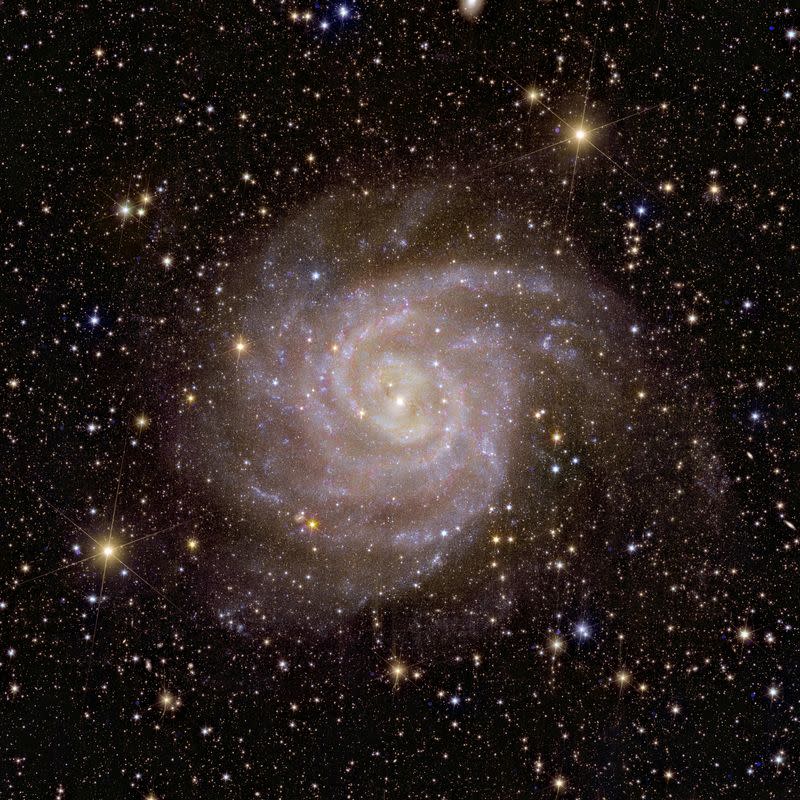
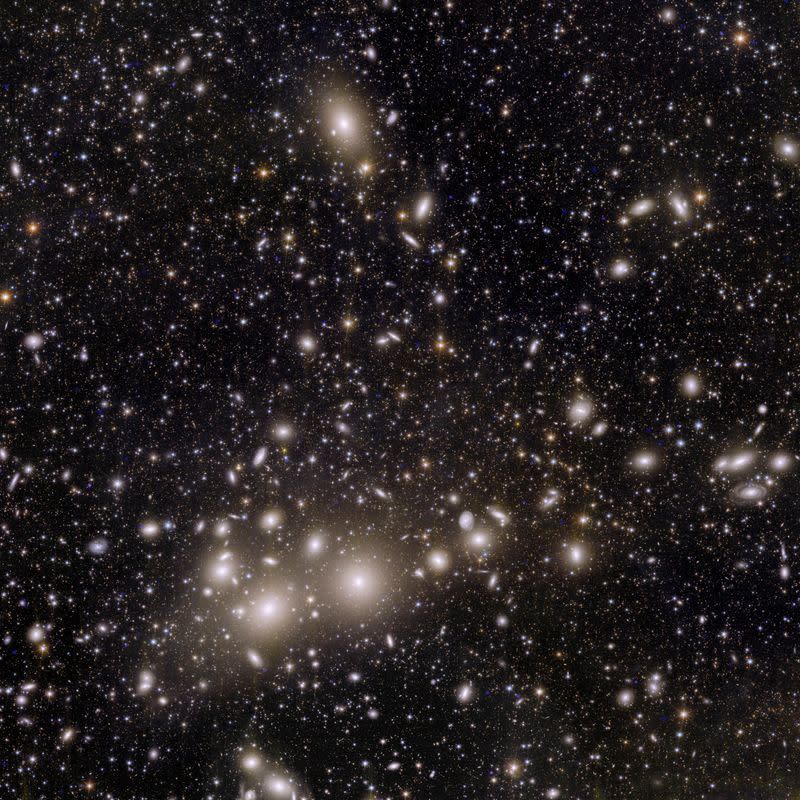
First images taken by Euclid telescope
By Tim Hepher
PARIS (Reuters) - European astronomers on Tuesday released the first images from the newly launched Euclid space telescope, designed to unlock the secrets of dark matter and dark energy - hidden forces thought to make up 95% of the universe.
The European Space Agency, which leads the six-year mission with NASA as a partner, said the images were the sharpest of their kind, showcasing the telescope's ability to monitor billions of galaxies up to 10 billion light years away.
The images spanned four areas of the relatively nearby universe, including 1,000 galaxies belonging to the massive Perseus cluster just 240 million light years away, and more than 100,000 galaxies spread out in the background, ESA said.
Scientists believe vast, seemingly organised structures such as Perseus could only have formed if dark matter exists.
"We think we understand only 5% of the universe: that's the matter that we can see," ESA's science director Carole Mundell told Reuters.
"The rest of the universe we call dark because it doesn't produce light in the normal electromagnetic spectrum. But we know its effect because we see the effect on visible matter."
Tell-tale signs of the hidden force exerted by dark matter include galaxies rotating more quickly than scientists would expect from the amount of visible matter that can be detected.
Its influence is also implicated in pulling together some of the most massive structures in the universe, like clusters of galaxies, Mundell said in an interview.
Dark energy is even more enigmatic.
Its hypothetical existence was established only in the 1990s by studying exploding stars called supernovas, resulting in a 2011 Nobel prize shared between three U.S.-born scientists.
Thanks in part to observations from the earlier Hubble Space Telescope, they concluded that the universe was not only expanding but that the pace of expansion was accelerating - a stunning discovery attributed to the new concept of dark energy.
3D COSMIC MAP
After initial commissioning and technical teething problems, including stray light and guidance issues, Euclid will now start piecing together a 3D map encompassing about a third of the sky to detect tiny variations attributable to the dark universe.
By gaining new insights into dark energy and matter, scientists hope to better grasp the formation and distribution of galaxies across the so-called cosmic web of the universe.
"The purpose of the Euclid mission is really to start to probe that dark sector of the universe in ways that we've been unable to presently with current ground and space missions," said Mundell, a leading academic and former UK science envoy.
"The Perseus cluster really typifies this huge conglomeration of mass. We think there's lots of dark matter in that cluster and pulling these galaxies together," she added.
The release of the images in Darmstadt, Germany, coincided with the second of two days of European space talks in Spain dominated by Europe's continued dependency on foreign launches.
The Euclid spacecraft was due to be launched on Russia's Soyuz rocket but those plans were scrapped amid a breakdown of relations following Moscow's invasion of Ukraine last year.
With Europe's own Ariane 6 rocket delayed, Euclid was launched from Florida by a SpaceX Falcon 9 rocket in July.
Although the mission is designed to last six years, ESA hopes Euclid has another six months of propellant to keep it in solar orbit some 1.5 million km (930,000 miles) away from Earth at "Lagrange Point Two", or L2 - a position of gravitational stability that is also home to NASA's James Webb Space Telescope.
Other images released by ESA included an irregular galaxy thought to resemble building blocks of the universe and a spiral formation known as the "Hidden Galaxy": a lookalike of our home galaxy usually obscured by light and dust within the Milky Way.
"You'll also see lots of background galaxies there as well, which is phenomenal. I think I spotted a new one there last night," Mundell told Reuters.
(Reporting by Tim Hepher; Additional reporting by Steve Gorman in Los Angeles; Editing by Alex Richardson)
First full-colour images of universe captured by Euclid telescope revealed
By Tim Hepher
PARIS (Reuters) - European astronomers on Tuesday released the first images from the newly launched Euclid space telescope, designed to unlock the secrets of dark matter and dark energy - hidden forces thought to make up 95% of the universe.
The European Space Agency, which leads the six-year mission with NASA as a partner, said the images were the sharpest of their kind, showcasing the telescope's ability to monitor billions of galaxies up to 10 billion light years away.
The images spanned four areas of the relatively nearby universe, including 1,000 galaxies belonging to the massive Perseus cluster just 240 million light years away, and more than 100,000 galaxies spread out in the background, ESA said.
Scientists believe vast, seemingly organised structures such as Perseus could only have formed if dark matter exists.
"We think we understand only 5% of the universe: that's the matter that we can see," ESA's science director Carole Mundell told Reuters.
"The rest of the universe we call dark because it doesn't produce light in the normal electromagnetic spectrum. But we know its effect because we see the effect on visible matter."
Tell-tale signs of the hidden force exerted by dark matter include galaxies rotating more quickly than scientists would expect from the amount of visible matter that can be detected.
Its influence is also implicated in pulling together some of the most massive structures in the universe, like clusters of galaxies, Mundell said in an interview.
Dark energy is even more enigmatic.
Its hypothetical existence was established only in the 1990s by studying exploding stars called supernovas, resulting in a 2011 Nobel prize shared between three U.S.-born scientists.
Thanks in part to observations from the earlier Hubble Space Telescope, they concluded that the universe was not only expanding but that the pace of expansion was accelerating - a stunning discovery attributed to the new concept of dark energy.
3D COSMIC MAP
After initial commissioning and technical teething problems, including stray light and guidance issues, Euclid will now start piecing together a 3D map encompassing about a third of the sky to detect tiny variations attributable to the dark universe.
By gaining new insights into dark energy and matter, scientists hope to better grasp the formation and distribution of galaxies across the so-called cosmic web of the universe.
"The purpose of the Euclid mission is really to start to probe that dark sector of the universe in ways that we've been unable to presently with current ground and space missions," said Mundell, a leading academic and former UK science envoy.
"The Perseus cluster really typifies this huge conglomeration of mass. We think there's lots of dark matter in that cluster and pulling these galaxies together," she added.
The release of the images in Darmstadt, Germany, coincided with the second of two days of European space talks in Spain dominated by Europe's continued dependency on foreign launches.
The Euclid spacecraft was due to be launched on Russia's Soyuz rocket but those plans were scrapped amid a breakdown of relations following Moscow's invasion of Ukraine last year.
With Europe's own Ariane 6 rocket delayed, Euclid was launched from Florida by a SpaceX Falcon 9 rocket in July.
Although the mission is designed to last six years, ESA hopes Euclid has another six months of propellant to keep it in solar orbit some 1.5 million km (930,000 miles) away from Earth at "Lagrange Point Two", or L2 - a position of gravitational stability that is also home to NASA's James Webb Space Telescope.
Other images released by ESA included an irregular galaxy thought to resemble building blocks of the universe and a spiral formation known as the "Hidden Galaxy": a lookalike of our home galaxy usually obscured by light and dust within the Milky Way.
"You'll also see lots of background galaxies there as well, which is phenomenal. I think I spotted a new one there last night," Mundell told Reuters.
(Reporting by Tim Hepher; Additional reporting by Steve Gorman in Los Angeles; Editing by Alex Richardson)
First full-colour images of universe captured by Euclid telescope revealed
Nina Massey, PA Science Correspondent
Tue, November 7, 2023
The first full-colour images of the universe captured by the space telescope Euclid have been released by the European Space Agency (ESA).
The five glittering pictures show galaxies and stars near and far, helping to uncover some of the universe’s hidden secrets.
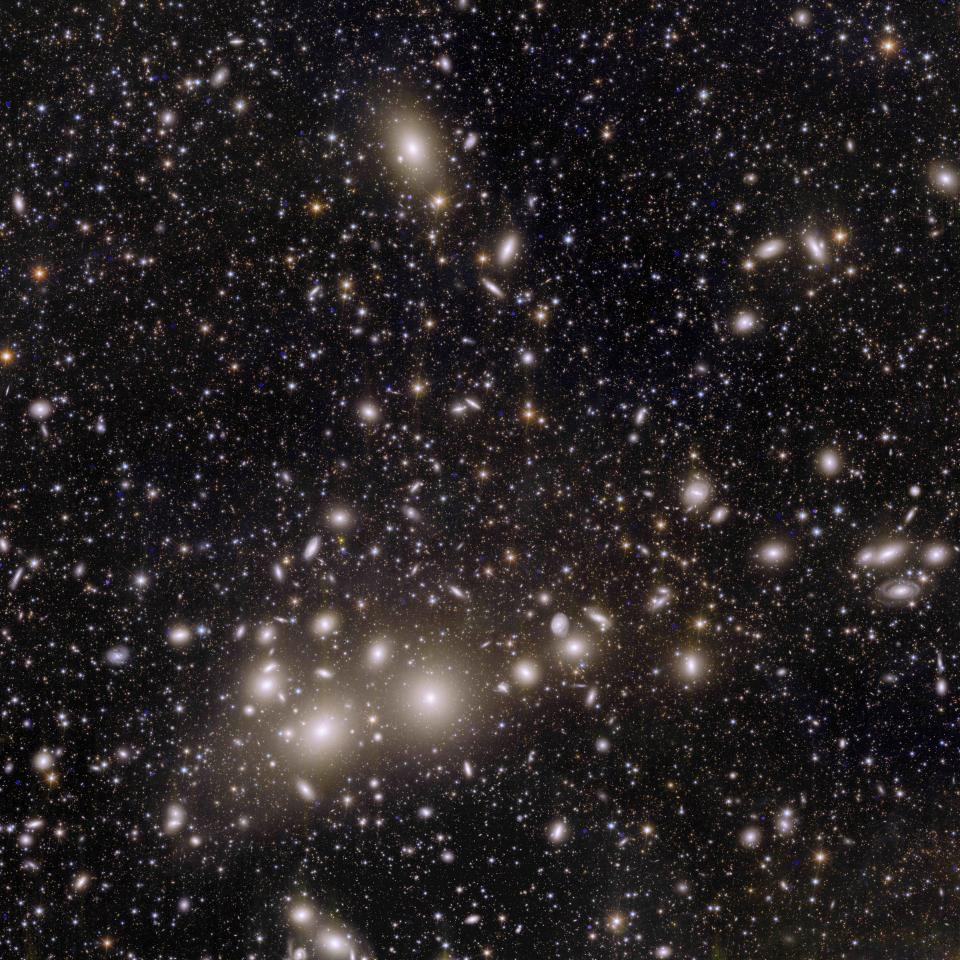
Euclid’s view of the Perseus cluster of galaxies (ESA/Euclid/Euclid Consortium/Nasa)
The images released on Tuesday include one of the Perseus cluster of galaxies which shows 1,000 galaxies belonging to the cluster, and more than 100,000 additional galaxies further away in the background.
Many of these faint galaxies were previously unseen, and some of them are so far that their light has taken 10 billion years to reach us.
Another image captures the spiral galaxy IC 342, nicknamed the Hidden Galaxy, because it is difficult to observe as it lies behind the busy disc of our Milky Way, and so dust, gas and stars obscure our view.
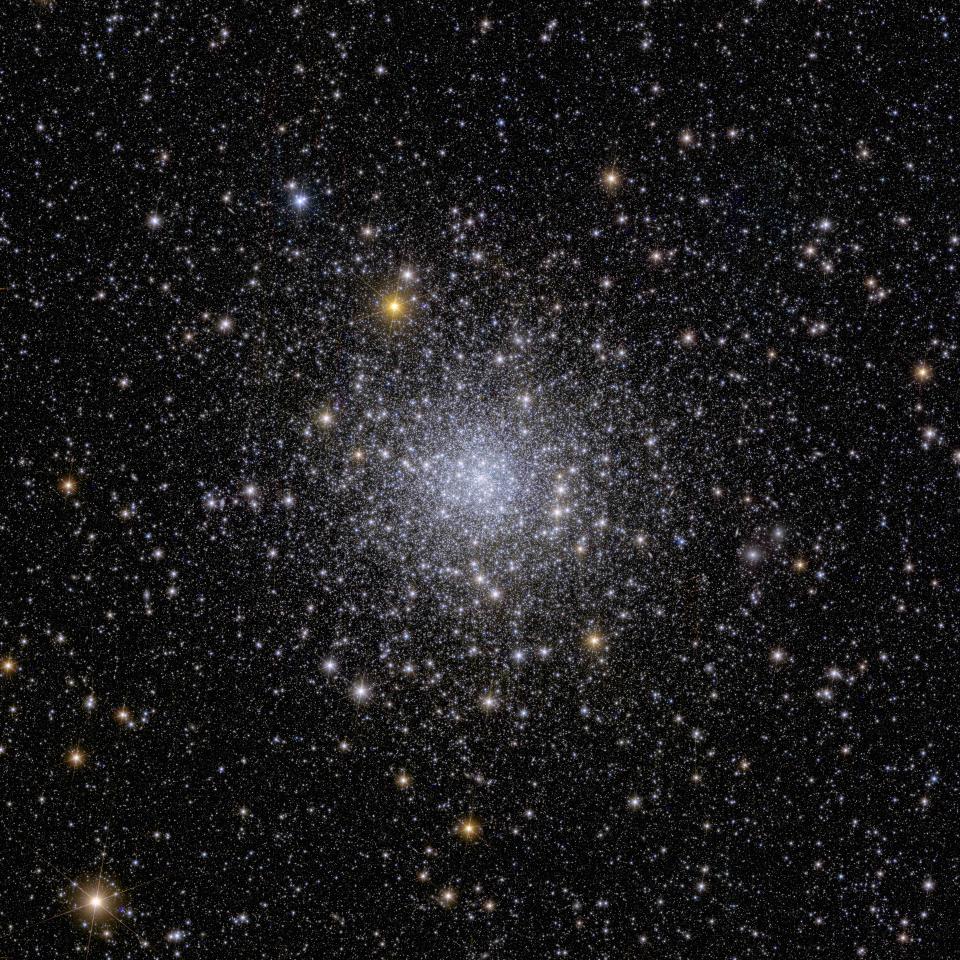
Euclid’s view of globular cluster NGC 6397 (ESA/Euclid/Euclid Consortium/Nasa)
One of the new pictures is of globular cluster NGC 6397 – the second-closest globular cluster to Earth, located about 7,800 light-years away.
Globular clusters are collections of hundreds of thousands of stars held together by gravity.
These faint stars tell us about the history of the Milky Way and where dark matter is located.
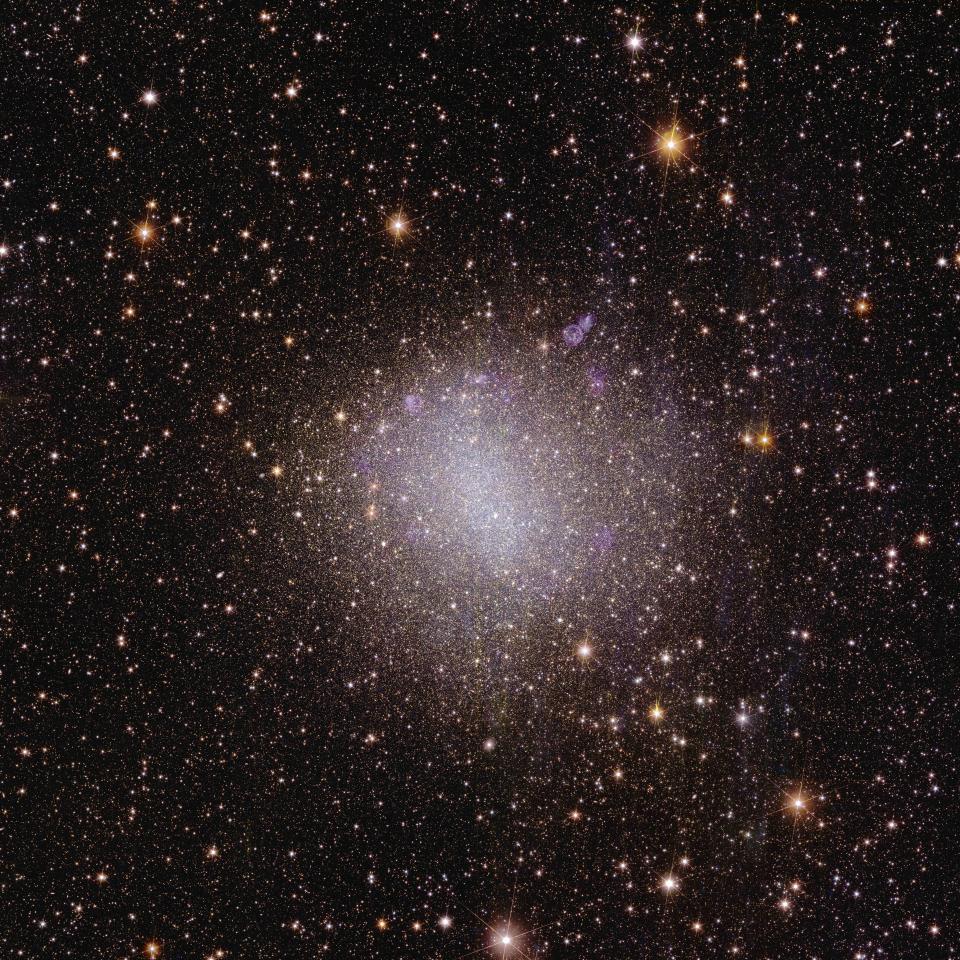
Euclid’s view of irregular galaxy NGC 6822 (ESA/Euclid/Euclid Consortium/Nasa)
To create a 3D map of the universe, Euclid will observe the light from galaxies out to 10 billion light-years.
The first irregular dwarf galaxy that Euclid observed is called NGC 6822 and is located just 1.6 million light-years from Earth.
And the fifth image shows a panoramic and detailed view of the Horsehead Nebula, also known as Barnard 33 and part of the constellation Orion.
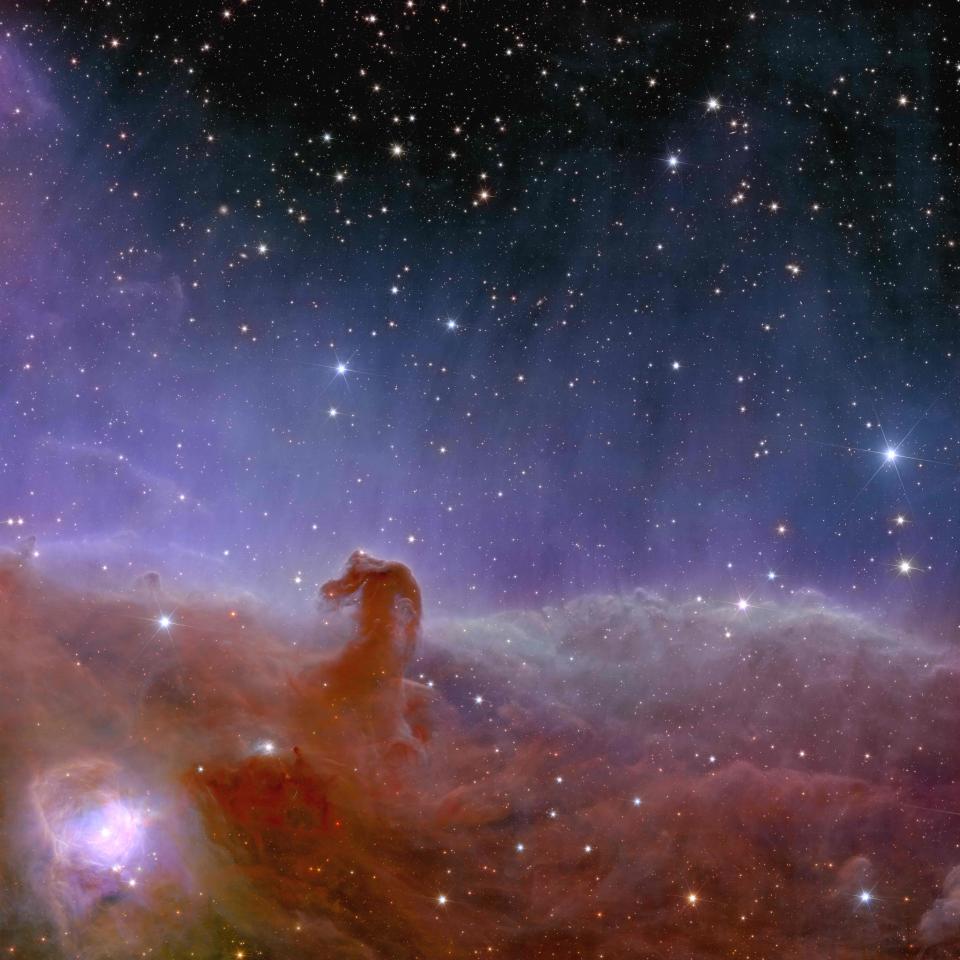
Euclid’s view of the Horsehead Nebula (ESA/Euclid/Euclid Consortium/Nasa)
Scientists hope to find many dim and previously unseen Jupiter-mass planets in their celestial infancy, as well as young brown dwarfs and baby stars, in this new observation.
Professor Carole Mundell, ESA director of science, said: “Dark matter pulls galaxies together and causes them to spin more rapidly than visible matter alone can account for; dark energy is driving the accelerated expansion of the universe.
“Euclid will for the first time allow cosmologists to study these competing dark mysteries together.
“Euclid will make a leap in our understanding of the cosmos as a whole, and these exquisite Euclid images show that the mission is ready to help answer one of the greatest mysteries of modern physics.”
Rene Laureijs, the ESA’s Euclid project scientist, said: “We have never seen astronomical images like this before, containing so much detail.
“They are even more beautiful and sharp than we could have hoped for, showing us many previously unseen features in well-known areas of the nearby universe.
“Now we are ready to observe billions of galaxies, and study their evolution over cosmic time.”
Euclid was launched on a SpaceX Falcon 9 rocket from Cape Canaveral in Florida on July 1.
Named after the ancient Greek mathematician Euclid, the two-tonne probe made its way towards an area in space known as the second Lagrange point, where the gravitational forces of Earth and the sun are roughly equal – creating a stable location for the spacecraft.
The UK has contributed £37 million towards the £850 million mission, with scientists playing key roles in designing and building the probe and leading on one of the two scientific instruments on board.
Dr Caroline Harper, head of space science at the UK Space Agency, said: “These first colour images showcase Euclid’s enormous potential, giving us incredibly sharp images of galaxies and stars, and helping us understand more about the impacts of dark matter and dark energy on the universe.
“The UK has played an important role in the mission, leading on the development of the visible imager (VIS) instrument and on key elements of the data processing pipeline, funded by the UK Space Agency.
“And this is just the start – UK researchers will be using Euclid data for many years to come to make significant new scientific discoveries about the composition and evolution of the cosmos.”
JWST Reveals Crab Nebula in Never-Before-Seen Detail
Cassidy Ward
Wed, November 8, 2023
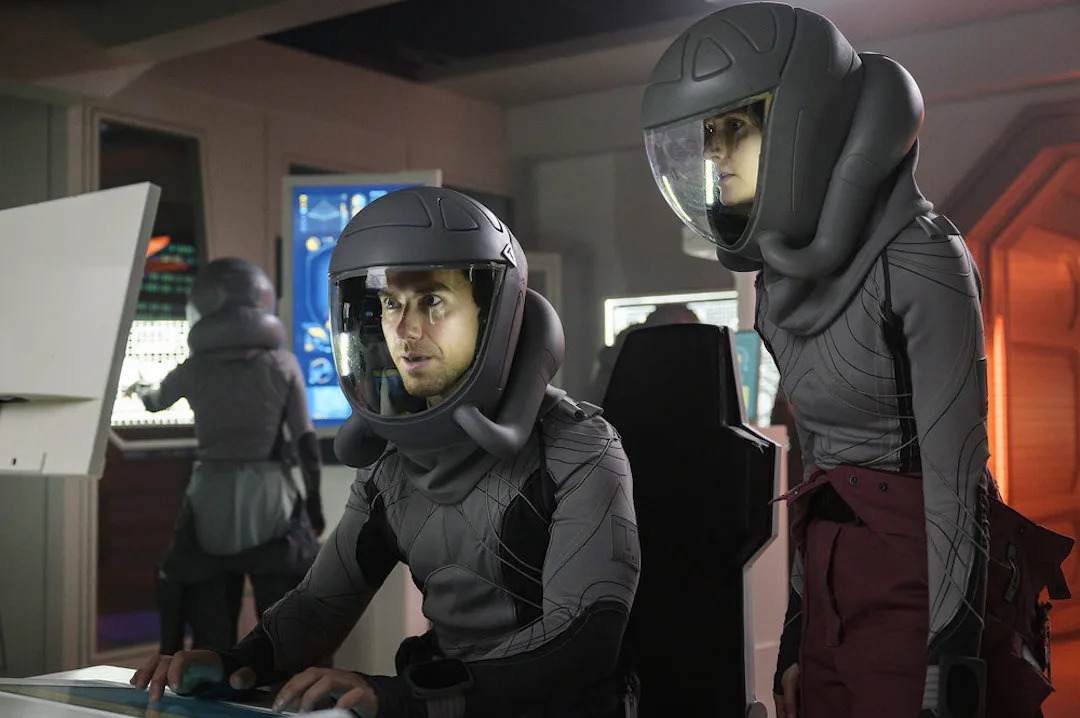
A century from now, the crew of SYFY's The Ark (streaming now on Peacock) extends the human passion for exploration to the stars. For the first time, a crewed spacecraft begins a journey to another star system and the planet Proxima centauri b, 4.2 light-years away. In the real world, perhaps we’ll actually be capable of that in a hundred years, but for now we’re limited to a pretty small territory around our own planet.
Still, the desire to explore persists, and we satisfy ourselves with building machines to go where we can’t go and see what we can’t see. Recently, the James Webb Space Telescope (JWST) captured new images of the famed crab nebula, giving us new insight into the evolution of a vast stellar explosion in our own galaxy.
JWST Image Gives New View of Old Friend, the Crab Nebula
The Crab Nebula is a supernova remnant, the leftover debris surrounding a pulsar, all that remains of a dead star. It’s located in the constellation Taurus at a distance of roughly 6,500 light-years. The nebula itself is expanding at an average rate of 1,500 kilometers per second and deep inside, a pulsar only 28 - 30 kilometers across is whipping around more than 30 times per second.
RELATED: Meet the Artemis II Astronauts, Set to Take NASA’s Historic 2024 Return Trip Around the Moon
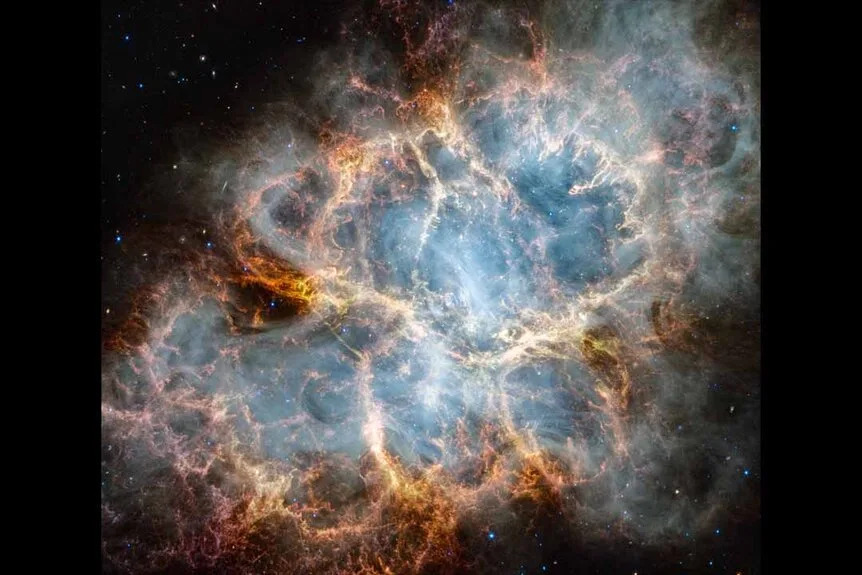
The Crab Nebula
JWST's Near-Infrared Camera (NIRCam) and Mid-Infrared Instrument (MIRI) capture detailed image of the Crab Nebula Photo: NASA, ESA, CSA, STScI, T. Temim (Princeton University)
It was first recorded as a temporary star by 11th Century Chinese astronomers in the year 1054. Despite being one of the most studied and beloved astronomical objects, JWST’s cutting edge instruments are providing details previously hidden from us. Using JWST’s Near-Infrared Camera (NIRCam) and Mid-Infrared Instrument (MIRI), astronomers have been able to more accurately see what the nebula is made of.
“Webb’s sensitivity and spatial resolution allow us to accurately determine the composition of the ejected material, particularly the content of iron and nickel, which may reveal what type of explosion produced the Crab Nebula,” said Lea Temim, a Stanford University astronomer who led the study, in a statement.
When compared with a historical image from the Hubble Space Telescope, the new image looks familiar enough that the nebula is recognizable at a glance. But a deeper look reveals unique details in both images. JWST’s infrared instruments highlight gaseous filaments at the nebula’s exterior as well as the structure and dispersal of dust grains in the interior. There is also significant synchrotron radiation, created as the pulsar’s intense electromagnetic field charges nearby particles like a supercollider. That radiation is visualized as milky white smoke throughout the nebula’s interior.
RELATED: The Crab Nebula hulks out, sends *incredibly* high-energy gamma rays at Earth
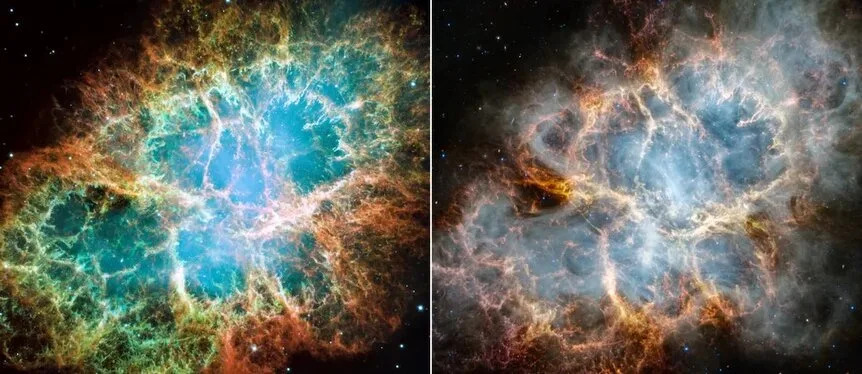
Side by side comparison of Hubble and JWST images of the Crab Nebula.
Side by side comparison of Hubble and JWST images of the Crab Nebula. Photo: Hubble Image: NASA, ESA, J. Hester, A. Loll (Arizona State University); Webb Image: NASA, ESA, CSA, STScI, T. Temim (Princeton University).
The nebula’s composition can also be seen in the image coloration. Ionized sulfur is represented in red and orange, ionized iron in blue, and dust grains in yellow, white, or green. Taken together with the Hubble images and observations from other telescopes around the world and in orbit, astronomers are peeling back layers to reveal more information about cosmic objects new and old.
By the time we manage to build our first interstellar ships, there’s no telling how the view of our favorite cosmic haunts (the Crab Nebula included) will have evolved. But we can’t wait to see it.
Cassidy Ward
Wed, November 8, 2023

A century from now, the crew of SYFY's The Ark (streaming now on Peacock) extends the human passion for exploration to the stars. For the first time, a crewed spacecraft begins a journey to another star system and the planet Proxima centauri b, 4.2 light-years away. In the real world, perhaps we’ll actually be capable of that in a hundred years, but for now we’re limited to a pretty small territory around our own planet.
Still, the desire to explore persists, and we satisfy ourselves with building machines to go where we can’t go and see what we can’t see. Recently, the James Webb Space Telescope (JWST) captured new images of the famed crab nebula, giving us new insight into the evolution of a vast stellar explosion in our own galaxy.
JWST Image Gives New View of Old Friend, the Crab Nebula
The Crab Nebula is a supernova remnant, the leftover debris surrounding a pulsar, all that remains of a dead star. It’s located in the constellation Taurus at a distance of roughly 6,500 light-years. The nebula itself is expanding at an average rate of 1,500 kilometers per second and deep inside, a pulsar only 28 - 30 kilometers across is whipping around more than 30 times per second.
RELATED: Meet the Artemis II Astronauts, Set to Take NASA’s Historic 2024 Return Trip Around the Moon

The Crab Nebula
JWST's Near-Infrared Camera (NIRCam) and Mid-Infrared Instrument (MIRI) capture detailed image of the Crab Nebula Photo: NASA, ESA, CSA, STScI, T. Temim (Princeton University)
It was first recorded as a temporary star by 11th Century Chinese astronomers in the year 1054. Despite being one of the most studied and beloved astronomical objects, JWST’s cutting edge instruments are providing details previously hidden from us. Using JWST’s Near-Infrared Camera (NIRCam) and Mid-Infrared Instrument (MIRI), astronomers have been able to more accurately see what the nebula is made of.
“Webb’s sensitivity and spatial resolution allow us to accurately determine the composition of the ejected material, particularly the content of iron and nickel, which may reveal what type of explosion produced the Crab Nebula,” said Lea Temim, a Stanford University astronomer who led the study, in a statement.
When compared with a historical image from the Hubble Space Telescope, the new image looks familiar enough that the nebula is recognizable at a glance. But a deeper look reveals unique details in both images. JWST’s infrared instruments highlight gaseous filaments at the nebula’s exterior as well as the structure and dispersal of dust grains in the interior. There is also significant synchrotron radiation, created as the pulsar’s intense electromagnetic field charges nearby particles like a supercollider. That radiation is visualized as milky white smoke throughout the nebula’s interior.
RELATED: The Crab Nebula hulks out, sends *incredibly* high-energy gamma rays at Earth

Side by side comparison of Hubble and JWST images of the Crab Nebula.
Side by side comparison of Hubble and JWST images of the Crab Nebula. Photo: Hubble Image: NASA, ESA, J. Hester, A. Loll (Arizona State University); Webb Image: NASA, ESA, CSA, STScI, T. Temim (Princeton University).
The nebula’s composition can also be seen in the image coloration. Ionized sulfur is represented in red and orange, ionized iron in blue, and dust grains in yellow, white, or green. Taken together with the Hubble images and observations from other telescopes around the world and in orbit, astronomers are peeling back layers to reveal more information about cosmic objects new and old.
By the time we manage to build our first interstellar ships, there’s no telling how the view of our favorite cosmic haunts (the Crab Nebula included) will have evolved. But we can’t wait to see it.


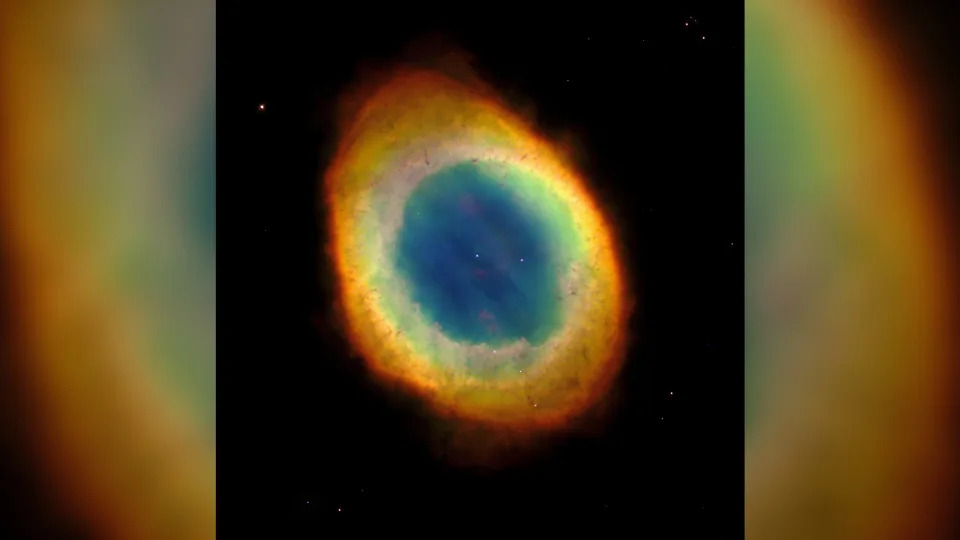

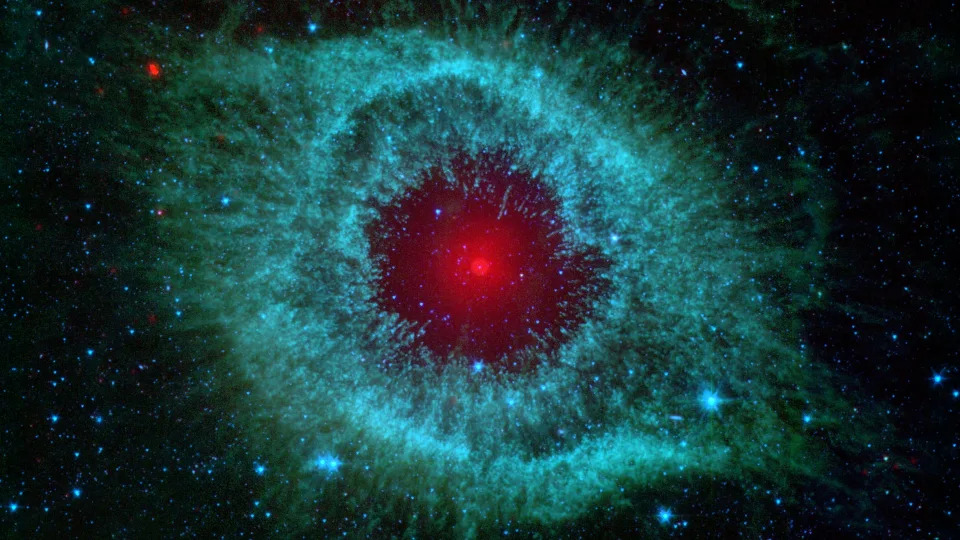
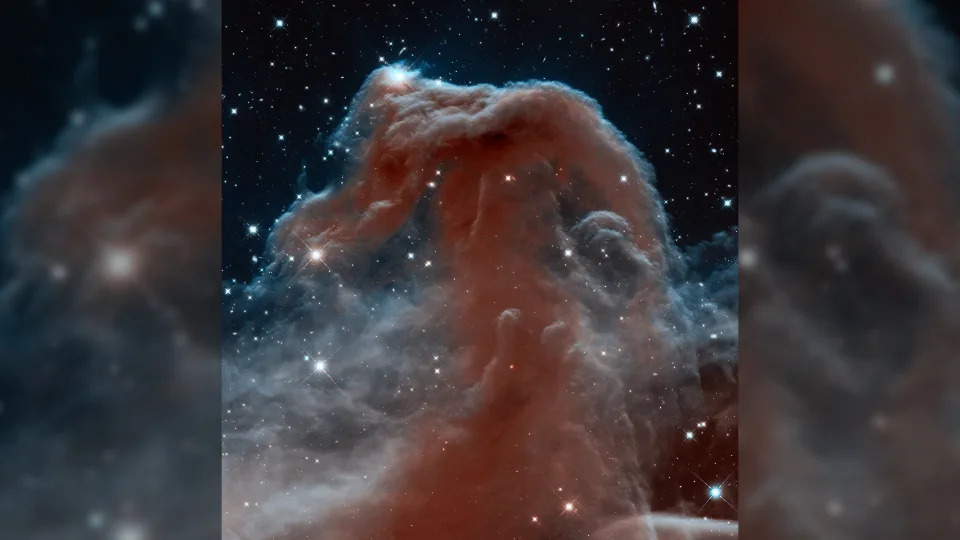
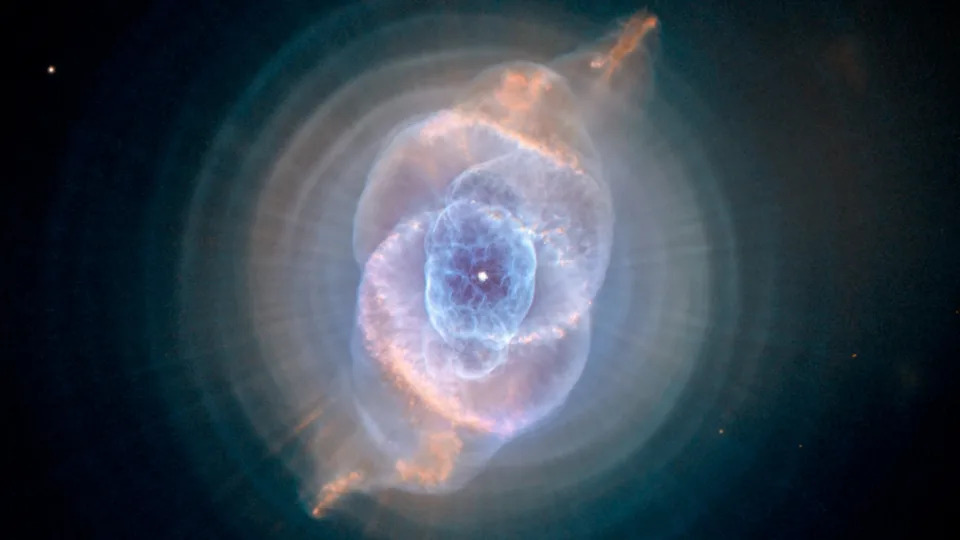
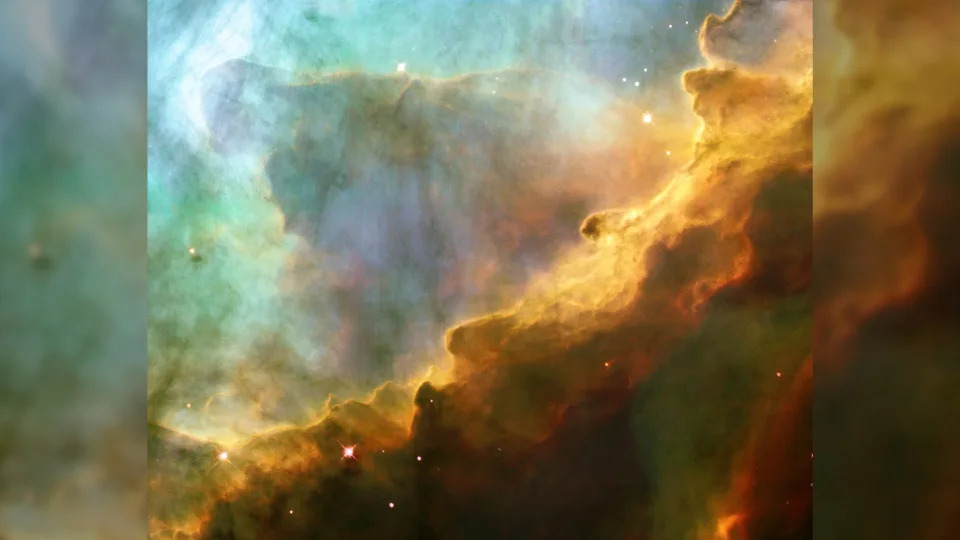
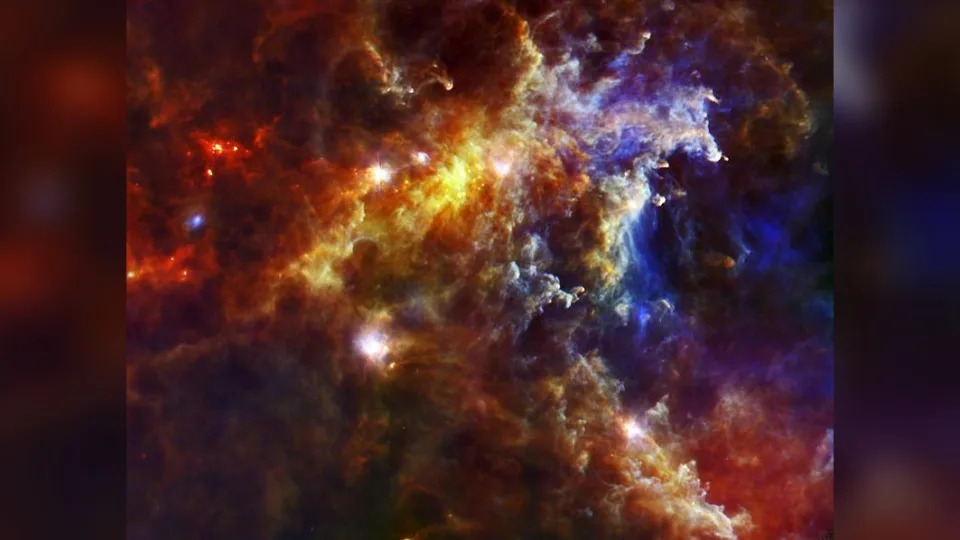
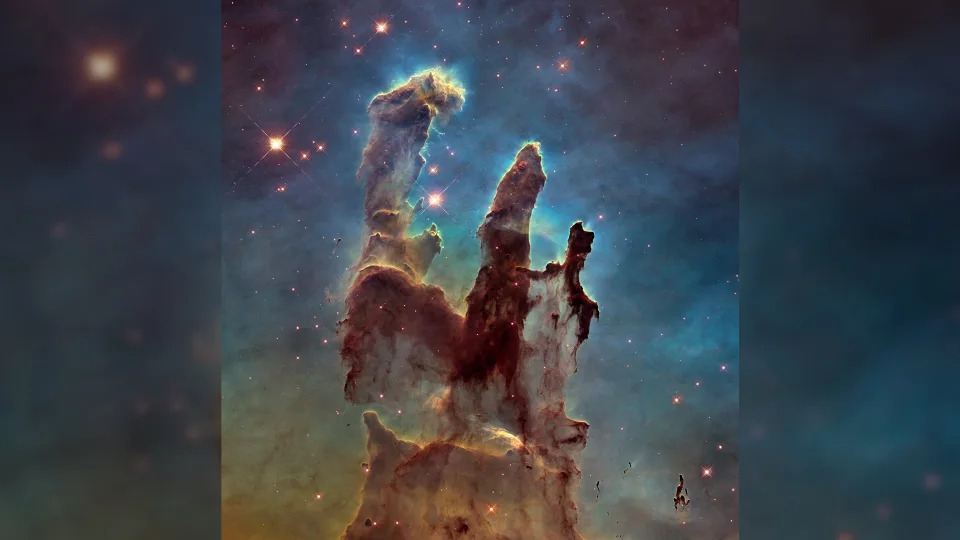
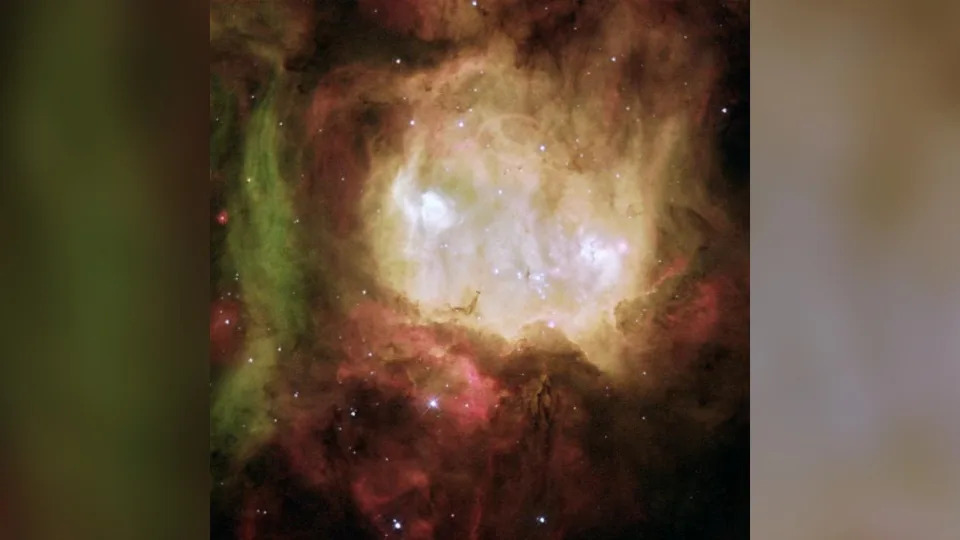


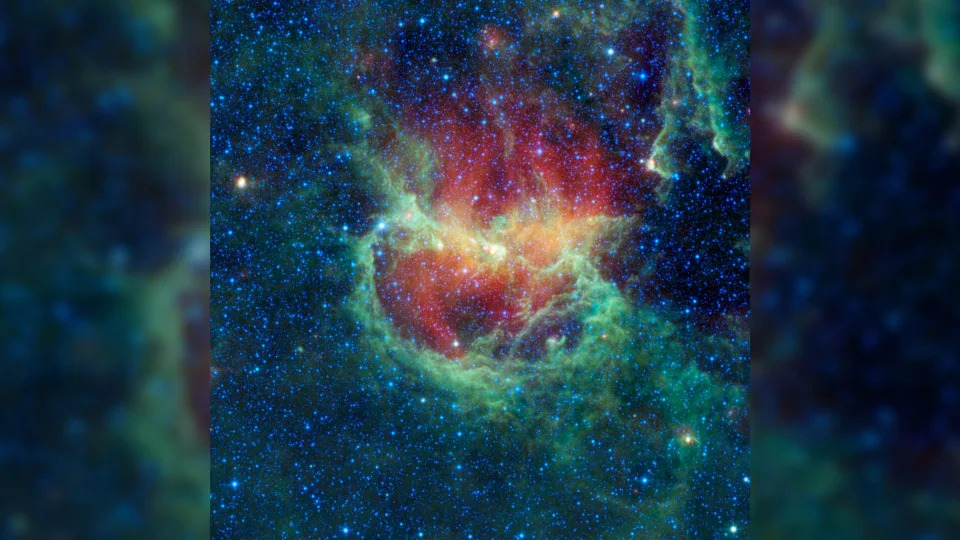

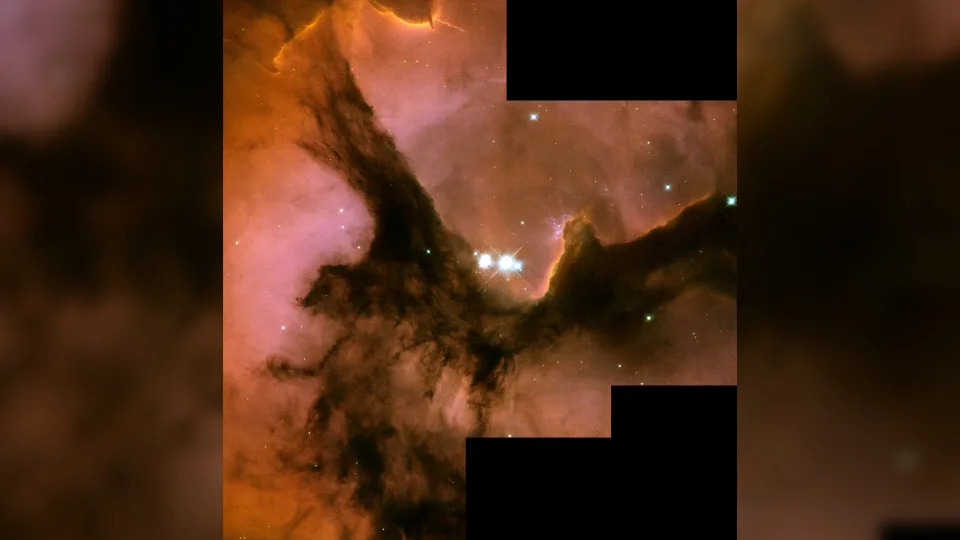

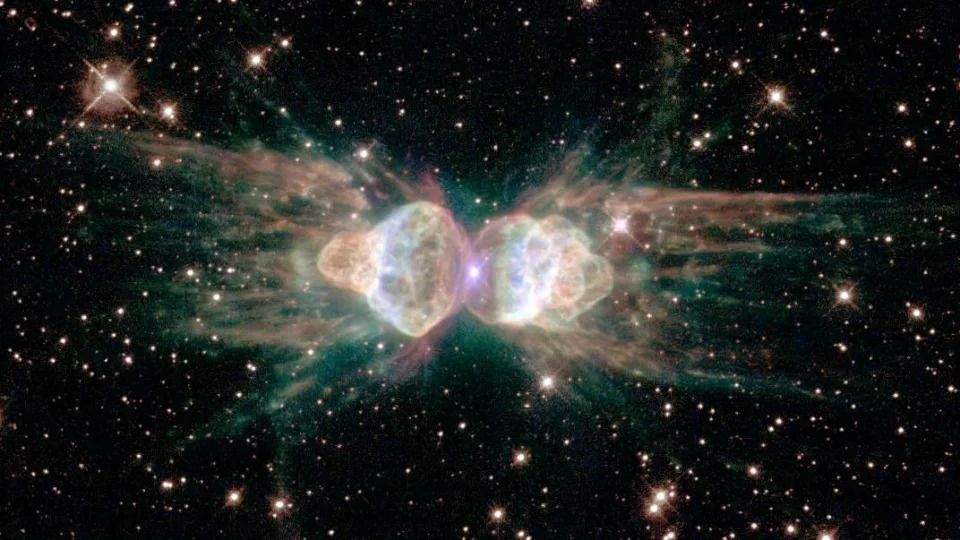
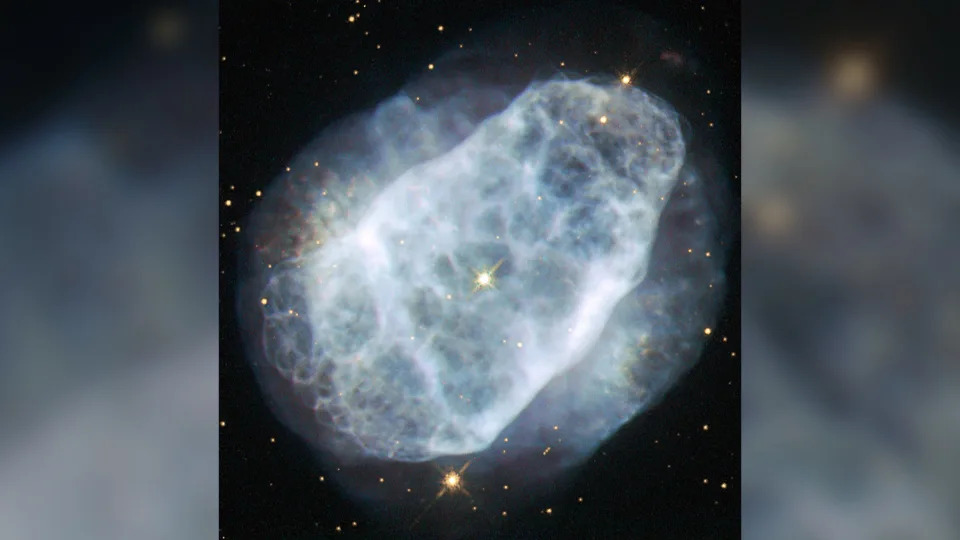
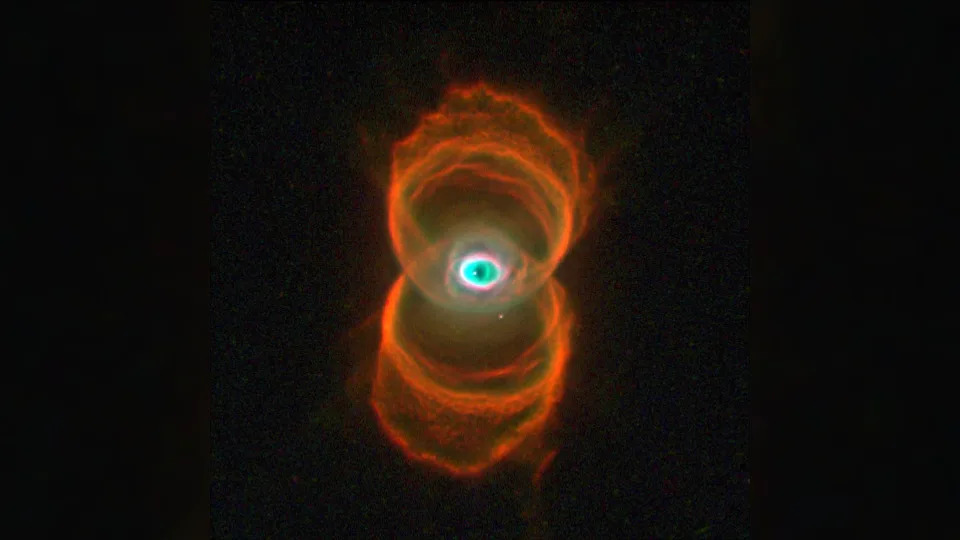




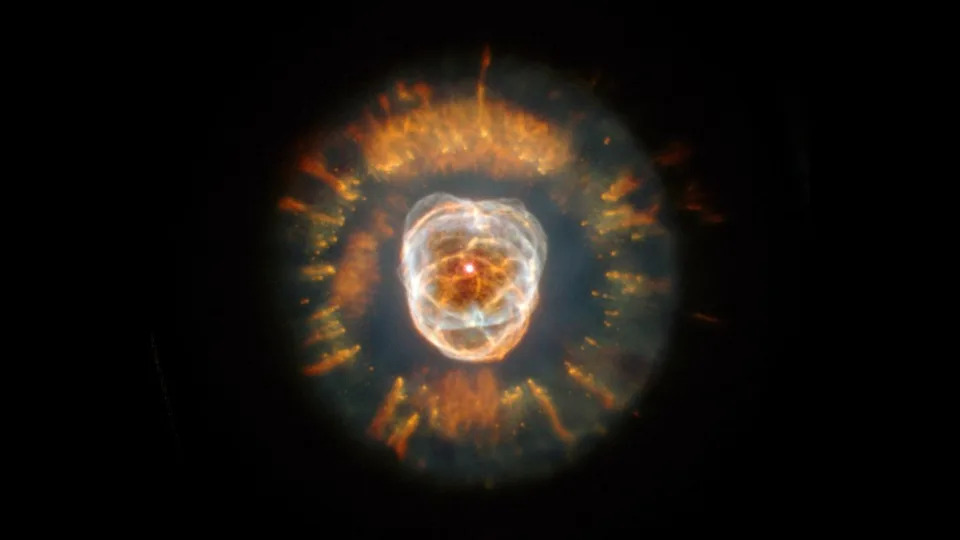
No comments:
Post a Comment